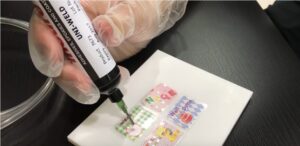Understanding the Basics
Epoxy and acrylic are both versatile materials commonly used in a variety of applications, from coatings and adhesives to art and crafts. While they share some similarities, they also have distinct properties that make them suitable for different purposes. Let’s delve into the key differences between these two materials.
Epoxy: The Versatile Workhorse
Epoxy is a two-part material that consists of a resin base and a hardener. When mixed together, the resin and hardener undergo a chemical reaction that causes the material to solidify. This process typically requires several hours to cure completely.
Key Advantages of Epoxy:
- Strength: Epoxy is known for its exceptional strength and durability, making it suitable for structural applications.
- Versatility: Epoxy can be formulated with a wide range of properties, including flexibility, hardness, and chemical resistance.
- Adhesion: Epoxy exhibits excellent adhesion to various surfaces, including metals, plastics, wood, and ceramics.
- Durability: Epoxy-cured materials are highly resistant to abrasion, chemicals, and weathering.
Common Applications of Epoxy:
- Coatings (floors, countertops)
- Adhesives (structural, marine, automotive)
- Composites (fiberglass, carbon fiber)
- Casting (art, jewelry)
Acrylic: The Clear Choice
Acrylic is a synthetic polymer that is typically transparent or translucent. It is known for its clarity, weather resistance, and ease of working with. Acrylic can be used in various forms, including sheets, tubes, and liquid resins.
Key Advantages of Acrylic:
- Clarity: Acrylic is highly transparent, making it ideal for applications where visibility is important.
- Weather Resistance: Acrylic is resistant to UV rays, moisture, and temperature extremes, making it suitable for outdoor use.
- Ease of Workability: Acrylic is relatively easy to work with, as it can be cut, drilled, and shaped without difficulty.
- Versatility: Acrylic can be used in a wide range of applications, from art and crafts to automotive and industrial components.
Common Applications of Acrylic:
- Sheets (windows, signs, displays)
- Tubes (aquarium tanks, plumbing)
- Liquid resins (casting, 3D printing)
- Art and crafts projects
Comparing Epoxy and Acrylic
| Feature | Epoxy | Acrylic |
|---|---|---|
| Type | Two-part material | Synthetic polymer |
| Appearance | Typically opaque | Transparent or translucent |
| Strength | Excellent | Good |
| Versatility | High | High |
| Weather Resistance | Good | Excellent |
| Ease of Workability | Moderate | Easy |
| Applications | Coatings, adhesives, composites, casting | Sheets, tubes, liquid resins, art and crafts |
Choosing the Right Material
The choice between epoxy and acrylic depends on the specific requirements of your application. Consider the following factors:
- Appearance: If you need a transparent or translucent material, acrylic is the better choice. For opaque materials, epoxy is a good option.
- Strength: For applications requiring exceptional strength and durability, epoxy is preferred. Acrylic is suitable for less demanding applications.
- Weather Resistance: If the material will be exposed to outdoor elements, acrylic is a good choice due to its weather resistance.
- Ease of Workability: If you need a material that is easy to work with, acrylic is a better option. Epoxy can be more challenging to work with, especially when mixed incorrectly.
- Applications: The specific application will also influence your choice. For example, epoxy is ideal for structural applications, while acrylic is well-suited for transparent or translucent components.
By carefully evaluating these factors, you can select the most appropriate material for your project.
Unsure if Epoxy or Acrylic is Right for Your Project? Contact Us or Explore the full range of Incure solutions at www.incurelab.com


